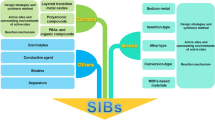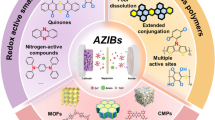Abstract
Sodium (Na)-ion batteries (NIBs) and potassium (K)-ion batteries (KIBs) have grabbed great attention because they are cheaper, more abundant in earth, and safer alternatives of lithium-ion batteries. However, the lack of anode materials for NIBs/KIBs with good performance has been the main obstacle. In this paper, we studied monolayer MnC by carrying out calculations on the basis of first principle study to see if it can be a potential anode material for NIBs and KIBs. Calculation results show that monolayer MnC processes good negative adsorption energies of − 2.83 eV for Na and − 2.16 eV for K. Moreover, MnC has comparable theoretical capacities for Na and K of 475 mAh/g and 253 mAh/g, respectively. Our calculation results manifest that the MnC can be a promising anode material for NIBs.

MnC monolayer absorbed with two layers of Na atoms






Similar content being viewed by others
References
Larcher D, Tarascon JM (2014) Towards greener and more sustainable batteries for electrical energy storage. Nat Chem 7(1):19–29
Chen H, Cong TN, Yang W, Tan C, Li Y, Ding Y (2009) Progress in electrical energy storage system: a critical review. Prog Nat Sci 19(3):291–312
Whittingham MS (2008) Materials challenges facing electrical energy storage. MRS Bull 33(4):411–419
Zhang D, Zhou Y, Liu C, Fan S (2016) The effect of the carbon nanotube buffer layer on the performance of a Li metal battery. Nanoscale 8(21):11161–11167
Li W, Yang Y, Zhang G, Zhang Y-W (2015) Ultrafast and directional diffusion of lithium in phosphorene for high-performance lithium-ion battery. Nano Lett 15(3):1691–1697
Yu T, Zhang S, Li F, Zhao Z, Liu L, Xu H, Yang G (2017) Stable and metallic two-dimensional TaC2 as an anode material for lithium-ion battery. J Mater Chem A 5(35):18698–18706
Goodenough JB, Park KS (2013) The Li-ion rechargeable battery: a perspective. J Am Chem Soc 135(4):1167–1176
Yu T, Zhao Z, Liu L, Zhang S, Xu H, Yang G (2018) TiC3 monolayer with high specific capacity for sodium-ion batteries. J Am Chem Soc 140(18):5962–5968
Wang D, Gao Y, Liu Y, Gogotsi Y, Meng X, Chen G, Wei Y (2017) Investigation of chloride ion adsorption onto Ti2C MXene monolayers by first-principles calculations. J Mater Chem A 5(47):24720–24727
Liu C-S, Yang X-L, Liu J, Ye X-J (2018) Theoretical prediction of two-dimensional SnP3 as a promising anode material for Na-ion batteries. ACS Appl Energy Mat 1(8):3850–3859
Mukherjee S, Kavalsky L, Singh CV (2018) Ultrahigh storage and fast diffusion of Na and K in blue phosphorene anodes. ACS Appl Mater Interfaces 10(10):8630–8639
Mukherjee S, Singh G (2019) Two-dimensional anode materials for non-lithium metal-ion batteries. ACS Appl Energy Mat
Pan H, Hu Y-S, Chen L (2013) Room-temperature stationary sodium-ion batteries for large-scale electric energy storage. Energy Environ Sci 6(8):2338
Slater MD, Kim D, Lee E, Johnson CS (2013) Sodium-ion batteries. Adv Funct Mater 23(8):947–958
Bie X, Kubota K, Hosaka T, Chihara K, Komaba S (2017) A novel K-ion battery: hexacyanoferrate (II)/graphite cell. J Mater Chem A 5(9):4325–4330
Shi L, Zhao TS, Xu A, Xu JB (2016) Ab initio prediction of a silicene and graphene heterostructure as an anode material for Li- and Na-ion batteries. J Mater Chem A 4(42):16377–16382
Er D, Li J, Naguib M, Gogotsi Y, Shenoy VB (2014) Ti3C2 MXene as a high capacity electrode material for metal (Li, Na, K, Ca) ion batteries. ACS Appl Mater Interfaces 6(14):11173–11179
Sannyal A, Zhang Z, Gao X, Jang J (2018) Two-dimensional sheet of germanium selenide as an anode material for sodium and potassium ion batteries: first-principles simulation study. Comput Mater Sci 154:204–211
Zhou Y, Li J (2018) Theoretical predication of a two-dimensional structure of non-layered ScC as an excellent electrode material for rechargeable Na-ion battery. Appl Surf Sci 462:417–422
Xie Y, Dall’Agnese Y, Naguib M, Gogotsi Y, Barsoum MW, Zhuang HL, Kent PR (2014) Prediction and characterization of MXene nanosheet anodes for non-lithium-ion batteries. ACS Nano 8(9):9606–9615
Share K, Cohn AP, Carter R, Rogers B, Pint CL (2016) Role of nitrogen-doped graphene for improved high-capacity potassium ion battery anodes. ACS Nano 10(10):9738–9744
Sultana I, Rahman MM, Ramireddy T, Chen Y, Glushenkov AM (2017) High capacity potassium-ion battery anodes based on black phosphorus. J Mater Chem A 5(45):23506–23512
Ladha DG (2019) A review on density functional theory–based study on two-dimensional materials used in batteries. Mat Today Chem 11:94–111
Olha Mashtalir MN, Mochalin VN, Dall’Agnese Y, Heon M, Barsoum MW, Gogotsi Y (2013) Intercalation and delamination of layered carbides and carbonitrides. Nat Commun 4 No. 1716
Halim J, Kota S, Lukatskaya MR, Naguib M, Zhao M-Q, Moon EJ, Pitock J, Nanda J, May SJ, Gogotsi Y, Barsoum MW (2016) Synthesis and characterization of 2D molybdenum carbide (MXene). Adv Funct Mater 26(18):3118–3127
Lukatskaya MR, Mashtalir O, Ren CE, Dall’Agnese Y, Rozier P, Taberna PL, Naguib M, Simon P, Barsoum MW, Gogotsi Y (2013) Cation intercalation and high volumetric capacitance of two-dimensional titanium carbide. Science 341(6153):1502–1505
C. Zhan, W. Sun, Y. Xie, D. Jiang, P. Kent, Computational discovery and design of MXenes for energy applications: status, successes, and opportunities, ACS applied materials & interfaces (2019)
Zhu J, Schwingenschlögl U (2017) P and Si functionalized MXenes for metal-ion battery applications. 2D Mat 4(2):025073
Eunjeong Yang HJ, Kim J, Kim H, Jung Y (2015) Exploring the possibilities of two-dimensional transition metal carbides as anode materials for sodium batteries. Phys Chem Chem Phys 17:5000–5005
Zhang B, Huang Y, Bao W, Wang B, Meng Q, Fan L, Zhang Q (2018) Two-dimensional stable transition metal carbides (MnC and NbC) with prediction and novel functionalizations. Phys Chem Chem Phys 20(39):25437–25445
Zhang RQ, Liu XM, Wen Z, Jiang Q (2015) Prediction of silicon nanowires as photocatalysts for water splitting: band structures calculated using density functional theory. J Phys Chem C 115(8):3425–3428
Perdew JP, Burke K, Ernzerhof M (1996) Generalized gradient approximation made simple. Phys Rev Lett 77(18):3865
Grimme S (2010) Semiempirical GGA-type density functional constructed with a long-range dispersion correction. J Comput Chem 27(15):1787–1799
Halgren TA, Lipscomb WN (1977) The synchronous-transit method for determining reaction pathways and locating molecular transition states. Chem Phys Lett 49(2):225–232
Perdew JP, Ernzerhof M, Burke K (1996) Rationale for mixing exact exchange with density functional approximations. J Chem Phys 105(22):9982–9985
Vineyard GH (1957) Frequency factors and isotope effects in solid state rate processes. J Phys Chem Solids 3(1–2):121–127
Kutner R (1981) Chemical diffusion in the lattice gas of non-interacting particles. Phys Lett A 81(4):239–240
Samad A, Shafique A, Shin Y-H (2017) Adsorption and diffusion of mono, di, and trivalent ions on two-dimensional TiS2. Nanotechnology 28(17):175401
Jiang H, Zhao T, Ren Y, Zhang R, Wu M (2017) Ab initio prediction and characterization of phosphorene-like SiS and SiSe as anode materials for sodium-ion batteries. Sci Bull 62(8):572–578
Jiang H, Shyy W, Liu M, Wei L, Wu M, Zhao T (2017) Boron phosphide monolayer as a potential anode material for alkali metal-based batteries. J Mater Chem A 5(2):672–679
Wang D, Liu Y, Meng X, Wei Y, Zhao Y, Pang Q, Chen G (2017) Two-dimensional VS 2 monolayers as potential anode materials for lithium-ion batteries and beyond: first-principles calculations. J Mater Chem A 5(40):21370–21377
Putungan DB, Lin S-H, Kuo J-L (2016) Metallic VS2 monolayer polytypes as potential sodium-ion battery anode via ab initio random structure searching. ACS Appl Mater Interfaces 8(29):18754–18762
Funding
This work is supported by the National Natural Science Foundation of China (Grant No. 61774023) and the Scientific and Technological Development Project of Jilin Province, China (Grant No. 20190101008JH).
Author information
Authors and Affiliations
Corresponding author
Additional information
Publisher’s note
Springer Nature remains neutral with regard to jurisdictional claims in published maps and institutional affiliations.
Rights and permissions
About this article
Cite this article
Chen, Q., Wang, H., Li, H. et al. Two-dimensional MnC as a potential anode material for Na/K-ion batteries: a theoretical study. J Mol Model 26, 66 (2020). https://doi.org/10.1007/s00894-020-4326-7
Received:
Accepted:
Published:
DOI: https://doi.org/10.1007/s00894-020-4326-7




